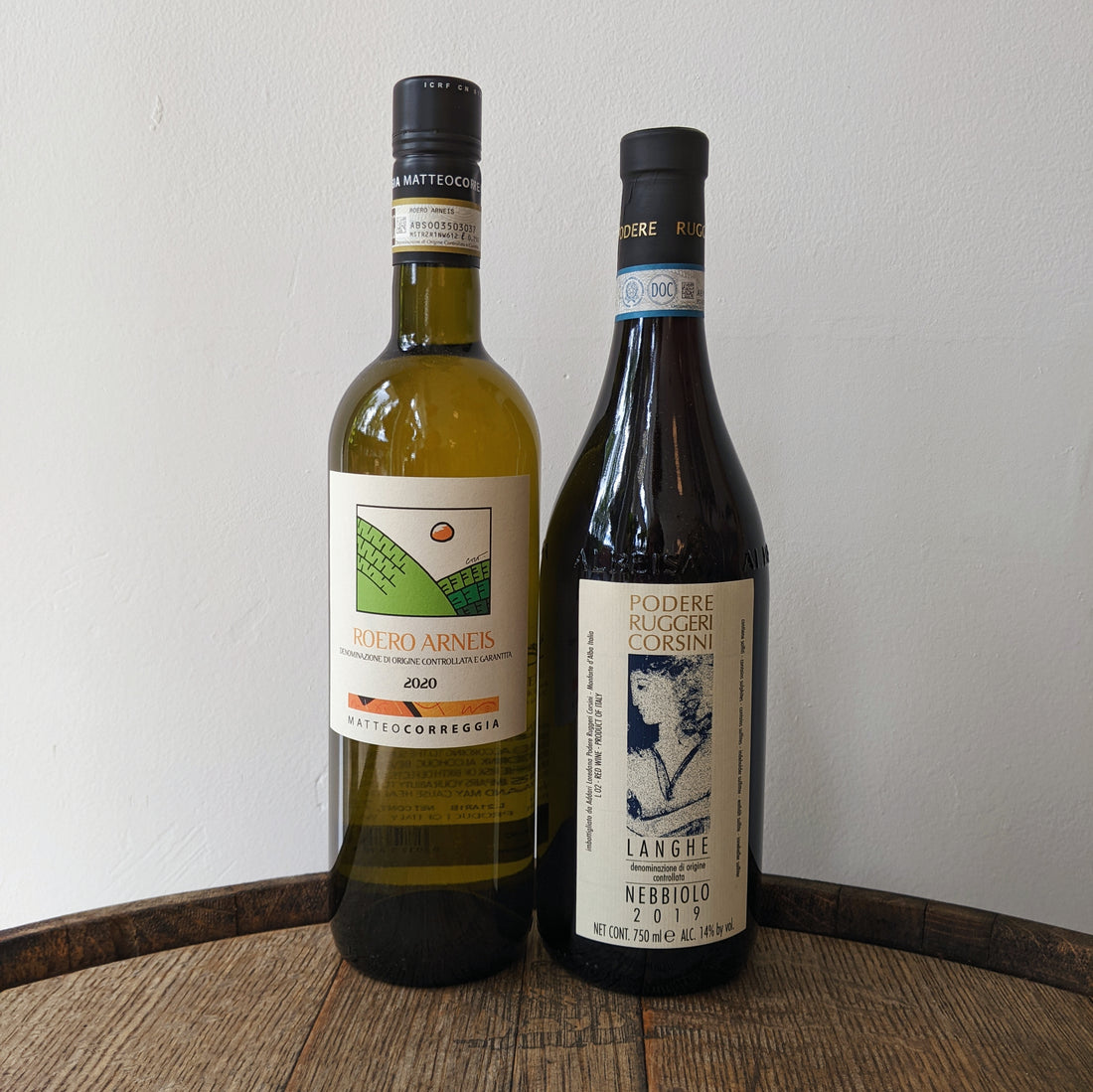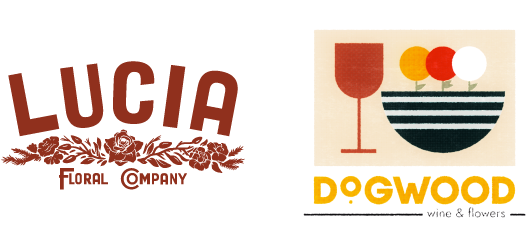
May 2022 - Piedmont, Italy
May 2022
Piedmont, Italy
Featuring:
Matteo Correggia, Roero Arneis 2020
Podere Ruggeri Corsini, Langhe Nebbiolo 2019
When learning about Italian wine, Piedmont is usually where people start. It is home to some of Italy’s best wines - the foreboding, ageable, ethereal Nebbiolo-based reds of Barolo and Barbaresco - and to some of the country’s most recognizable daily drinkers - Barbera, Dolcetto, Gavi and more. Even if you’re a relative newcomer to wine and don’t know what any of the words above mean, you’ve probably drank something from Piedmont at some point. Let’s dig in.
Piedmont, or Piemonte in Italian, means foothills or more literally ‘Foot of the Mountain’ in Italian. It’s the meeting point of the Apennines (the mountain chain that runs N-S up Italy’s spine) and the Alps (which need no introduction). Here, in the rolling foothills of both these mountains, scenic hill-top villages are surrounded by vineyards and mixed agriculture, much int the European tradition.
The climate is defined by the warm Mediterranean sea to the south and the cooler air coming off the Alps. During the growing season, cool air will come off the mountain cooling the warm, sun-baked hillsides. The moisture from the earth will precipitate into fog and hang around all morning. Once the warm afternoon sun returns, the fog burns off and the grapes get a good dose of UV rays to continue their ripening process. The benefit of this is the cooler nighttime/morning temperatures allow the grapes to turn off photosynthesis and lock in acidity. The warm temperatures then help bump sugar content. The result can be wines that are high in alcohol and tannin but still retain a wonderful acidity.
So, let’s talk about grapes. The undisputed star of the show is Nebbiolo. Its home, and where it achieves its highest form, is in Piedmont. Many have tried to replicate this style elsewhere in the world, but no one has quite perfected it. Speculation and a bit of common sense says Nebbiolo is named after La Nebbia (fog in Italian) or, more appropriately, Nebula, which is the Latin term for the word. I often describe Nebbiolo as a paradox because it is High Acid / High Tannin but Lower in body and intensely floral. You can smell a Nebbiolo and get bright cherry, rose petals, and bright elegant notes, but the second you take a sip your palate is assaulted by the intense structure of the wine. Only after years of aging does the grape settle down and soften a bit.
The vineyards surrounding the small village of Barolo are often considered the best source of the grape, producing some of the biggest and most structured wines while the neighboring village of Barbaresco produces slightly lighter, more lifted and delicate expressions of the grape. Moreover, there are a ton of other secondary regions - Carema, Gattinara, Carema, Lessona, and more not even in Piedmont (like Valtellina). In some of these places it is called by a pseudonym, Spanna, and tends to be lighter and slightly more savory. There’s also one of my favorites, Langhe Nebbiolo, which comes from the immediate area surrounding Barolo / Barbaresco (the area is called the Langhe), and may or may not be sourced from younger vines within those regions that didn’t make the cut for the big name wine. As always, finding that under-the-radar value wine is a goal for us!
Next up would be the disagreeable step-sibling pair of Dolcetto and Barbera, often lumped together but wildly different. Dolcetto would be the easiest drinking, least serious of the two. Usually consumed within the first few years of life, most Dolcetto is dark-fruited, often tannic, and lower in acid. It’s an easy-drinker meant for bigger and more structured food pairings. Barbera, on other hand, is bright with high acid and lower tannins. Electric and juicy with crunchy fruit, Barbera is practically the inverse of Dolcetto but similar in two key regards - both are early drinkers, considered to be perfect for consuming ‘while the Nebbiolo ages’, and both are easier to ripen than the notoriously finicky Nebbiolo, and are grown on the parts of the hillsides that may not have the ample heat or sun exposure to ripen the other grape.
There’s a ton of other red grape varieties, but you’re unlikely to encounter most unless you’re seeking them out. Some of these can be very captivating, though! Instead, we will focus on white grapes! Of the whites of Piedmont, the most interesting and popular of these days is Arneis (pronounced aR-nase, meaning little rascal in the local dialect). Originally a very popular wine in the Piedmont, Arneis was steadily replaced by Nebbiolo, reaching a low point in the 1970s, when only two producers remained in production of it (Bruno Giacosa and Vietti). Thankfully the 80s saw a renaissance of Italian whites and plantings increased again, with most producers focusing on the sub-region of Roero for its ability to produce the best Arneis. The wines tend to be dry and full-bodied, with notes of peaches, apricots, and stone fruit. It often has a classic Italian bitter finish, but not always. Coretese is another fantastic white from the area. Often sold and referred to simply as the region it comes from - Gavi - this grape is simple, with a flinty/minerally backbone and crisp apple and lemon notes. Some of the best Gavi’s can be wildly complex but most are simple table wines meant for quick consumption.
The most known of Piemontese white grapes is probably Moscato. The Italian name for the Muscat Blanc grape (which is one of the oldest and most widespread varieties) is also synonymous with a certain style of wine produced in the Piedmont. These tend to be low alcohol, semi-sweet, lightly sparkling wines that are intensely aromatic with notes of honeysuckle, orange marmalade, pear and lemon. While many may scoff at the idea of this, there are a ton of serious producers making wine in this style - it’s a great drink to go with light, fruity desserts. Or raucous Vegas pool parties… your choice.
Matteo Correggia, Roero Arneis 2020
While Roero may be the appellation where the Arneis grape achieves near-perfection, it’s also capable of decent Nebbiolo production. Much of the innovation and effort to elevate this appellation for both red and white was heralded by Matteo Correggia, a young winemaker who gained an international reputation early. Sadly Matteo passed away in a tractor incident in 2001. He was just 39 years old. Local winemakers rallied around his wife, Ornella, and helped her continue the family business until their son, Giovanni, was capable of stepping up. Today, Giovanni, age 30, acts as the brand ambassador and sales manager in the off-season and focuses on learning to make the wines under longtime winemaker Luca Rostagno during the harvest.
Today, the family farms roughly 20 hectares (50 acres) of vineyards and focuses on sustainable methods, both in the winery and in the field. Like many of our producers, I would hesitate to classify them as a ‘natural winery’ in the sense that their products are very pristine and classic, however the methods they follow are in line with natural winemaking principles - organic viticulture, low-SO2 additions, native yeast fermentations.
It would be fair to call this a ‘benchmark’. That is to say, wines that achieve perfect varietal typicity (like this one, for Arneis) are important tools when thoughtfully tasting future expressions of the grape against. Utterly classic, the Correggia Arneis is grown on 500-750 feet of elevation on silty clay soils. Once harvested, it is very gently pressed and fermented in temp-controlled stainless steel. Released after just 6 months of age, it’s an expression looking to be drunk young and cold. Notes of juicy peach and pears, with hints of melon, mint, tarragon and a touch of marzipan. It’s wildly approachable but still serious, with a plush mouthfeel and driving acid. Wonderful with all things creamy and cheesy. I’d be quicker to pair this with fall flavors (squash blossoms, white sauce pastas) than spring peas and favas, however that works because this weather feels more like autumn than spring.
Podere Ruggeri Corsini, Langhe Nebbiolo 2019
In a region (and country) where most of the wineries have roots that run generations–deep, Podere Ruggeri Corsini is an infant. Founded in 1995 by Loredana Addari and Nicola Argamante - two viticulture and enology students looking to start a winery - Ruggeri Corsini has quickly become a household name in many Piedmont circles. Located in the town of Monforte d’Alba (or rather 2km outside it), the winery is entirely family-owned, run by the couple and their eldest daughter.
Not to be a broken record, this family is also focused on sustainability in the vineyards. They do everything mentioned above and even take it a step further, looking at all facets of production and sales to make sustainable choices. Some recent initiatives include: opting for thinner, lighter glass bottles to reduce glass waste and shipping emissions, phyto-purification of wastewater, and solar panels powering the winery and tasting room. Italy, the birthplace of the slow food movement, has long been a driving force in sustainable agriculture and wineries like these two are important pieces of that larger, global issue.
The family farms 25 acres of vineyards in the hamlet of Corsini, located directly north of Monforte d’Alba. Here, they are in the Barolo DOCG right along the southern Border. Within Barolo, much of the land has been delineated further into “Cru’s”, however the Corsini estate is just outside of any, perched just between the Bricco San Pietro, Bussia, and Ginestra cru’s.
They do make a wine from both Bussia and Bricco San Pietro - their top two wines - but those are not from the estate property. This Langhe Nebbiolo, on the other hand, comes entirely from their estate within Barolo. And while it is not aged to the requirements that Barolo is, it is a worthy alternative for more casual consumption. So, to put it more bluntly, this is a wine from Barolo, made with grapes that go into Barolo, but released younger than most and at about half of the price.
Once harvested in October, the grapes go through a quick destemming followed by an eight day fermentation. Once secondary fermentation is finished, it’s then aged for 12 months in neutral slavonian oak barrels before bottling. (in contrast, if it was labeled Barolo would be aged 18+ months in Oak and 36 months total before release). The end result is a pleasing and soft wine, with a definite presence of grip and tannin. Violets, cherries, black pepper and roses present on the nose. It is immediately drinkable, but could also be left in the basement for another 10 years. Your choice! Pair with something stew-y and savory. Once again, following the fall/winter theme!
